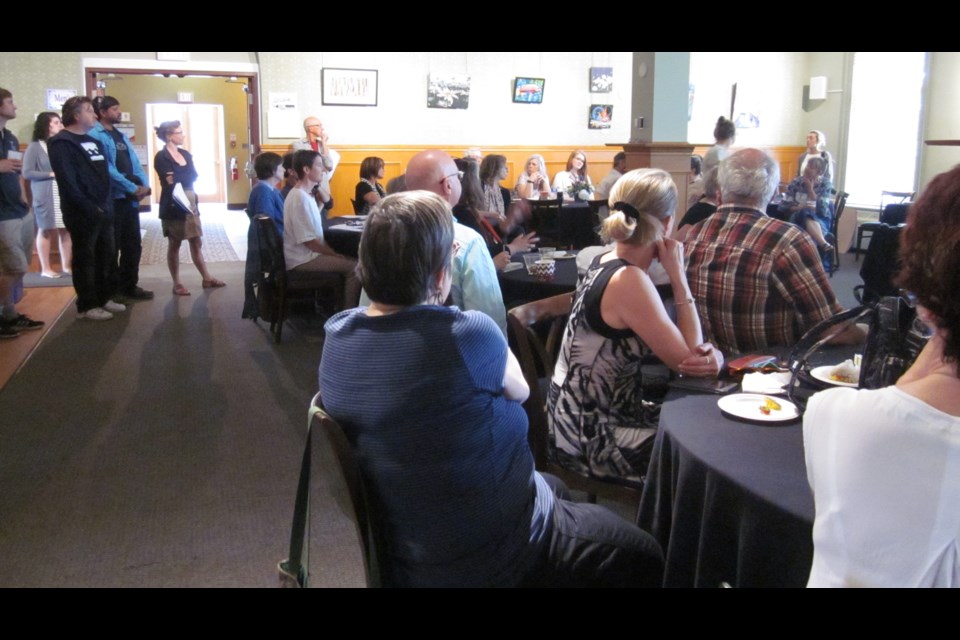Do we already have a cultural hub or hubs in Orillia? That was one of the questions floated during the Creating Space for Arts and Culture Roundtable June 19 at the Orillia Opera House.
Jointly hosted by the City of Orillia Department of Parks Recreation and Culture, the Orillia District Arts Council (ODAC), the Orillia Cultural Roundtable and Artsbuild Ontario, the public forum was an open invitation for artists and other interested members of the community to engage in a dialogue about what a cultural hub looks like to them … or if we already have one or more in our fair city.
Orillia Cultural Roundtable co-chair and local champion of arts and culture John Swartz served as master of ceremonies of the event and coordinated the questions and answers around the room.
City of Orillia Manager of Culture Jacqueline Soczka and Artsbuild Ontario representative Alex Glass also took a turn at the microphone to help guide the conversation.
After introducing the event by pointing to other roundtables and community discussions which had led to changes in Orillia, such as saving Regan House, the city’s public art policy, the designation of the Peter Street Arts District, and the city’s cultural calendar workshops, Swartz pointed out the city currently has three cultural centres happening or about to happen.
The three Swartz mentioned were Creative Nomad Studios, coming to the old BiWay downtown in the fall; Ontario Artspace which has no physical home yet but many ideas and plans: and the Orillia Centre for Arts and Culture, which has been programming events of national importance for three years, but also has no physical home.
Glass cited many examples of creative hubs currently operating throughout southern Ontario, and not just in Toronto. Some are city-owned and non-profit operated, while others are fully non-profit, or collaborations with developers in some way.
All are sustainable, have financial support, fill a demonstrated need in the community, had a champion or champions to lead the way, space for creative industries, an accessible location (in all meanings of the word), and, ideally, tied back to their local economic development, cultural or master plan of their municipality.
Armed with this information, participants, including many local artists, members of city council, art champions, and artrepreneurs, were instructed to answer three questions.
Firstly, does Orillia have a cultural hub or hubs and what does it look and feel like to you? What should it have?
Secondly, think about what conveniences you would like or what would motivate you to make use of a creative hub?
And thirdly, thrown out into the audience generally: What can you contribute to make a creative hub a reality?
The approximately 50 participants jumped into answering the questions and conversations were animated as the questions were discussed.
Fred Larsen, chair of Orillia Centre for Arts and Culture, and people at his table, were the ones who brought up the idea of Orillia already having multiple hubs, in the ODAC, the Orillia Museum of Art and History, and the Peter Street Arts District.
Later in the event, an official from the Orillia Public Library and Orillia Opera House manager Wendy Fairbairn both spoke passionately about their facilities being cultural hubs as well.
“Come and see me, my door is open,” Fairbairn said. “We have space and would love to support artists. I love art, and we want to be part of the community.”
The library is also willing and able to help out.
“We have equipment, we have a 3D printer, we have software, a lino cutter, we can get people going and then they can take over on their own. We love to collaborate, we welcome you to come to us with your ideas.”
Other ideas that flowed from the group included making sure a cultural hub space was a safe and supportive space; that people could work together but also have privacy; that it have flexible spaces and hours; that it be affordable; that it be accessible in all ways; that there be spaces for both ‘clean’ and ‘dirty’ art (welding, woodworking, pottery); that there be opportunities for collaboration, mentoring, critique, and casual inspiration from other members; and that there be communication.
Local artist Peter Fyfe brought up the idea of the space being a place for community, for sharing rich ideas and for collaboration - for more than just artists but for people to share and be together.
Organizers and participants alike seemed pleased with the evening, although one participant did mention a similar conversation being held in 2007, with another council and another manager of culture.
Regardless, many notes were taken and many Post It notes of many colours were collected at the end of the evening.
Hopefully, the organizers of the three hubs already in the making and here now, who were present at the meeting, took note of what is being looked for and will use the information moving forward.
And, hopefully also, the city will be able to use the information to decide how to support our local creatives.
